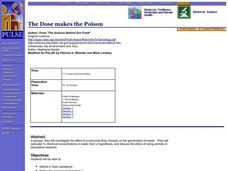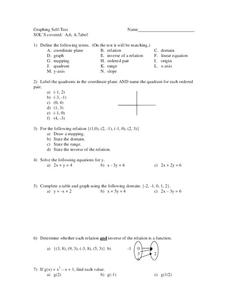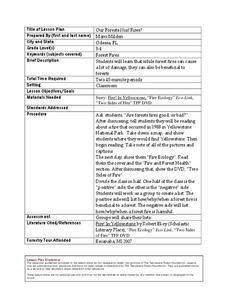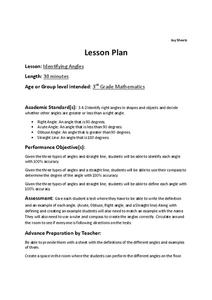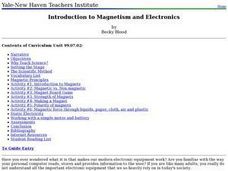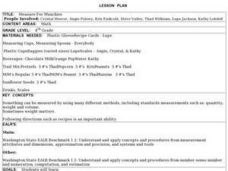Curated OER
Ordering Numbers C
In this math worksheet, students order three-digit numbers from the least to greatest. Students also order numbers from greatest to least.
Curated OER
Some People Just Don't Get It
In this daily mind builders worksheet, students use inferential reasoning and deduction. Students read a short passage and respond to 6 short answer questions stating their own opinion and providing evidence to support their conclusion.
Curated OER
Water Filtration
In this water pollution and filtration lesson plan, 5th graders read the story 'Saving Salila's Turtle' and discuss the impact pollution has had on the Ganges river. Students work in groups to brainstorm different types of water...
Curated OER
Extreme Flashlight Tag
Fifth graders view a Powerpoint show about reflecting light. They experiment through a reflection simulation on the internet. Students complete the activity by using mirrors and light to complete send light to a specified spot.
Curated OER
The Dose makes the Poison
Young scholars investigate the effect of a chemical (they choose) on the germination of seeds. They calculate % chemical concentrations in water, form a hypothesis, and discuss the ethics of using animals in biomedical research.
Curated OER
Bouncing off the Walls
Third graders compare the bouncing height of different types of balls. In this science lesson, 3rd graders explain the importance of repeated experimentation in science. They record their result and share them with the class.
Curated OER
Simple Harmonic Motion with Dr. DAQ
Young scholars study the work and accomplishment of Galileo. In this physics lesson, students calculate the period of a pendulum's using a mathematical equation. They explain the different factors affecting its period.
Curated OER
Energy Sources
Learners identify natural resources and describe the difference between renewable and non-renewable resources. They also identify the disadvantages and advantages of the resources.
Curated OER
Levers
Fifth graders participate in a review discussion of the parts of a lever, resistance or load, fulcrum, and effort. Next, they complete activities at six experiment stations while collecting data that they share with the class. While...
Curated OER
Parametric Projectile Motion
Learners relate projectile motion to parametric equations as they identify the velocity and angle of a projectile. They create a picture on the navigator to visualize the word problem.
Curated OER
Using Memoirs to Open Doors to Research
Interesting memoirs can be a springboard into some very enjoyable research assignments.
Curated OER
Effigy Mound Activity
Students research effigy mounds of Native people in Wisconsin. They create large models of effigy mounds in a given area based on factual information from their studies and research.
Curated OER
Earthquakes
Learners inspect the causes and effects of earthquakes and examine how seismic waves travel. For this earthquake lesson, students determine where earthquakes happen and why, before determining how to build an earthquake resistant...
Curated OER
Graphing
In this graphing worksheet, 9th graders solve and graph 8 different problems that include defining various terms related to graphing. First, they label the quadrants in a coordinate plane and name the quadrant for each listed ordered...
Curated OER
Design in Production
Students are introduced to product design. In this social studies and technology lesson plan, students examine the historical role of mass production in the development of American business and industry and then apply their knowledge in...
Curated OER
Our Forests Need Fires?
Young scholars consider how forest fires are both damaging and beneficial to forests. In this earth science lesson, students are read the book Fire! In Yellowstone by Robert Ekey and watch "Fire Ecology" and "Two Sides of Fire" before...
Curated OER
Identifying Angles
Third graders analyze angles and determine if they are acute, right, or obtuse. In this angles lesson, 3rd graders study the definition and characteristics of each angle. Students then do a worksheet to identify the name of the angle.
Curated OER
Slush Rush
Young scholars navigate software to help students understand the benefits of computer models. In this computer models lesson, young scholars use computer inquiry tools to record simulated events and how they affect objects such as...
Curated OER
Surfing the Waves
Learners use online resources, including animations,to define the slope of a curve and how to calculate the slope. They solve 8 problems online, using the definition of the derivative of a function at a point to calculate slope of the...
Curated OER
The Blue Bottle: An Example of Teacher-Guided Inquiry
Learners observe a demonstration in which a bottle containing a colorless solution is mixed, turns blue, then becomes colorless again. They record observations, form and discuss hypotheses, and draw a conclusion based on the evidence.
PBS
Predicting/Making a Hypothesis
Students analyze information from a variety of sources in order to create a hypothesis about the origin of an interesting family artifact.They create alternative hypotheses based upon available information to demonstrate that some...
Curated OER
Introduction to Magnetism and Electronics
Students are introduced to the concepts of magnetism and electronics. As a class, they walk through the steps of the scientific method and define new vocabulary. In groups, they are given a bag of objects and they are to separate them...
Curated OER
Measure for Munchies
Fourth graders are introduced to the various types of measurements. Using a recipe, they practice measuring out the correct amount of ingredients while making the food. They also practice using a scale and following the directions on a...
Curated OER
Language Arts/Science: Genetic Diseases Simulation
Eighth graders engage inn role-playing activities as families caring for babies with genetic defects. A partial list of activities include: dressing the babies ( raw eggs), designing birth certificates, and recording a log of care,...






